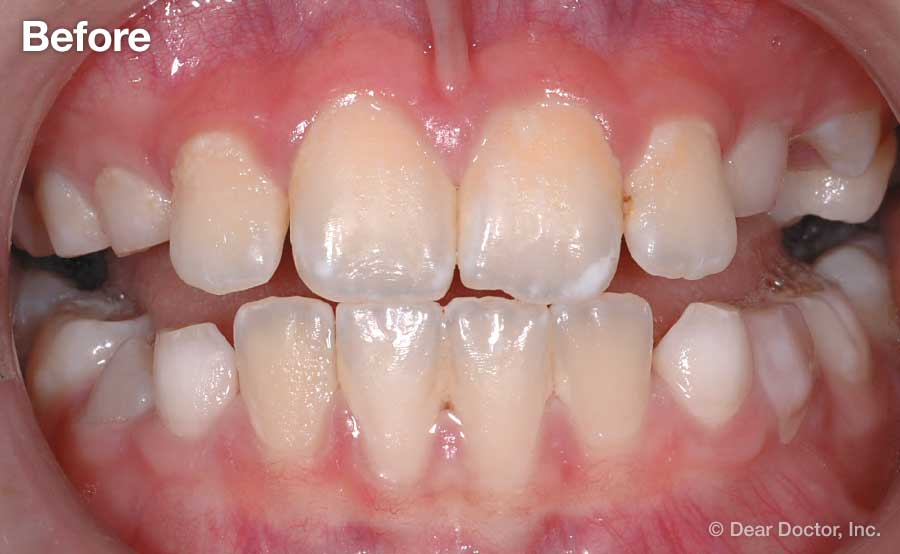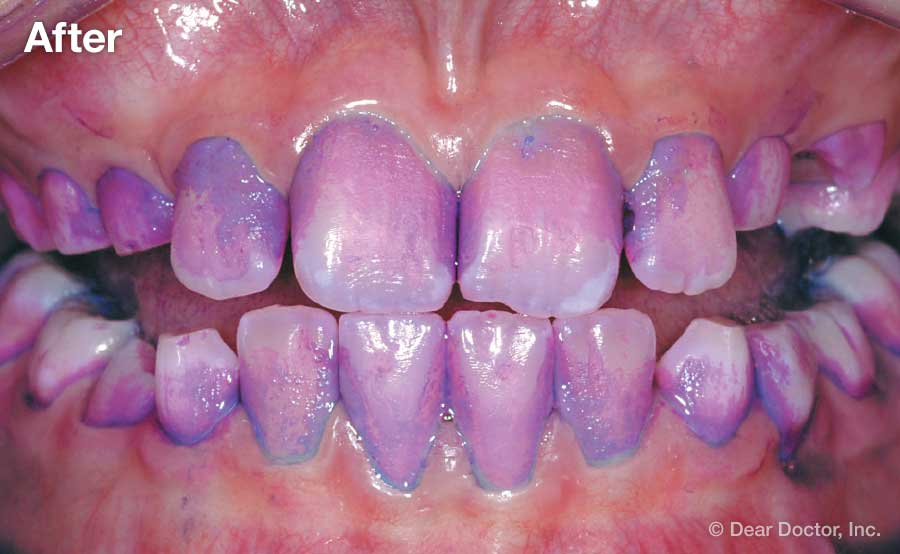Plaque Disclosing Agents
A good way to find out if your oral hygiene is up to par
Dear Doctor,
Should I use a disclosing solution?
Dear Monica,
Ask almost anyone if they're doing a good job brushing their teeth, and chances are they will say "yes!" But since the point of brushing and flossing is to remove dental plaque from hard-to-reach surfaces of your teeth — and since it's often difficult to tell whether plaque is present or not — how can you tell for sure? A disclosing agent provides the answer.
Dental disclosing agents, which include solutions, swabs and tablets, can show you exactly how well you are cleaning your mouth. These products contain a dye that temporarily stains and reveals plaque, the colorless film of bacteria that sticks stubbornly to your teeth. Once you can actually see the problem, it is easier to brush it away. But before we talk about using a disclosing agent, let's find out why it is so important to remove plaque.
 |
| 11-year-old child before disclosing solution is used. To the naked eye, it is impossible to see bacterial plaque. |
 |
| Same child after disclosing solution is used. The purple stain highlights older bacterial plaque and the pink, newer plaque. |
Why fight plaque?
Plaque is a soft, sticky biofilm that contains millions of bacteria (plus carbohydrates and other substances), which forms naturally in the mouth every day. It grows on the surfaces of your teeth, gets below the gum line, and sticks to fillings and other dental work. It's almost impossible to prevent plaque, but it is possible to remove it with good brushing and flossing — and it's important! When plaque bacteria are allowed to build up, it can lead to tooth decay and gum disease.
Here's how it happens: The bacteria in accumulated plaque feed on the sugar and starch in your diet, and then produce acids which attack tooth enamel (the hard outer surface of the tooth). Repeated attacks can cause cavities. Plaque bacteria can also irritate and inflame the gums, causing periodontal (gum) disease.
It is easiest to remove plaque while it is still new and soft. Left undisturbed, it starts to harden and within days turns into a mineralized deposit called tartar (dental calculus) where plaque and bacteria continue to thrive. Tartar can only be removed at the dental office — brushing and flossing will simply not budge it!
Seeing is believing
Even if you brush regularly, it's possible that a significant amount of plaque can be left behind. Plaque is colorless and well camouflaged, especially in hard-to-see areas like the back of the mouth. Many people are unaware how much biofilm has collected, or where it is located.
Dental hygienists sometimes use disclosing agents in the office to show their patients this accumulated plaque. However, you can just as easily use these products at home. They are available over-the-counter and come in various flavors and forms including tablets, pre-loaded swabs, or solutions. Here's how to do it:
After brushing and flossing, swish the liquid around the mouth for about 30 seconds, and then spit like you would a mouthwash; or, chew the tablet or use the swab as directed. A dye (such as erythrosine, for example, a cherry-pink synthetic commonly used for food coloring) reacts with plaque, staining it a bright color. There are even some two-tone agents available, which offer more information by staining new and old plaque two different colors.
You can use your bathroom mirror, or even a small dental mirror, to get a closer look at any staining. The areas highlighted will tell you where you need to pay more attention to your brushing and flossing. For example, if you see red plaque scalloping the gum line, you will know exactly where you need to do a better job. Then, floss and brush away as much of the dye as you can on the tooth surface. Once you are done, your teeth should be pearly white and free of any disclosing stain — and you will know you did a better, more efficient job removing plaque.
If you're concerned about hygiene efficiency, you can use a disclosing agent regularly until you see less and less plaque. Then, followup every few weeks to make sure you are on track with your brushing and flossing.
Some people may be uncomfortable with the idea of a brightly colored mouth (the color can also get onto your gums, tongue, or lips), but remember the staining is temporary and will wear off in a few hours. Even though the dye has been approved for use in the mouth, avoid swallowing it or getting it on clothes, and if you are prone to allergies thoroughly review the list of ingredients before use.
A little extra help
While everyone can benefit from them, disclosing agents are particularly useful for kids, people at high risk for cavities and gum disease, and those with orthodontic appliances or dental work that may make brushing difficult.
The bright colors and flavors can be appealing to youngsters. You can make a game out of it by showing them the colorful spots on their teeth, and teaching them how to brush the spots away.
Several studies have confirmed the benefits of disclosing agents, and the American Dental Association has recommended them to check the efficiency of your brushing and flossing. Talk to your hygienist about disclosing agents — especially if you are at a high risk for decay or gum disease… or if your kids may be. So, to help arm yourself in the fight against plaque: stain, swish, spit, and smile!




